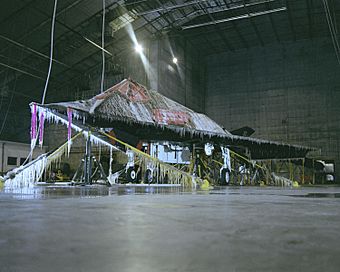McKinley Climatic Laboratory facts for kids
Quick facts for kids |
|
|
McKinley Climatic Laboratory
|
|

F-117A, 84-0824, on ice at McKinley Climatic Laboratory in 1991
|
|
| Nearest city | Fort Walton Beach, Florida |
|---|---|
| Built | 1944 |
| Architectural style | Late 19th And Early 20th Century American Movements |
| NRHP reference No. | 97001145 |
| Added to NRHP | October 6, 1997 |
The McKinley Climatic Laboratory is a special place at Eglin Air Force Base in Florida. It's a huge lab where engineers test airplanes and other equipment. They check how these machines work in extreme weather conditions.
This lab is used by the United States Air Force and other government groups. Even private companies can use it to test their products. It's not just a lab; it's also a historic site. On October 6, 1997, it was added to the National Register of Historic Places. In 1987, it was named a Historic Mechanical Engineering Landmark.
Contents
Why the Lab Was Built
In 1940, the US Army Air Force needed a way to test planes in very cold weather. They used to go to Fairbanks, Alaska, but the cold weather there wasn't always reliable. It could be too warm or not last long enough.
A smart person named Ashley Chadbourne McKinley had a great idea. He suggested building a giant refrigerated hangar. This way, they could create their own cold weather whenever they needed it. The lab was built at Eglin Air Force Base.
Testing Aircraft and More
The first tests at the McKinley Climatic Laboratory began in May 1947. Many famous airplanes were tested there. These included the B-29 Superfortress, the P-47 Thunderbolt, and the P-51 Mustang. Even early jet planes like the P-80 Shooting Star were put to the test.
More recently, the lab has tested very large planes like the C-5 Galaxy. Stealth aircraft like the F-117 and the F-22 have also been tested. Even modern passenger planes, such as the Boeing 787 and the Airbus A350 XWB, have gone through tests here.
On June 12, 1971, the main hangar was named the McKinley Climatic Hangar. This was done to honor Ashley Chadbourne McKinley, who first suggested building the amazing facility.
Inside the McKinley Lab
The McKinley Climatic Laboratory is made up of several important parts. The main building, called Building 440, is a huge, insulated hangar. It also has offices, a special room for testing engines, and a system to make things hot or cold.
The Main Test Chamber
The main chamber is like a giant refrigerator. It's about 252 feet (77 meters) wide, 201 feet (61 meters) deep, and 70 feet (21 meters) tall. It was first built to hold large planes like the B-29. Later, it was made even bigger to test planes as huge as the C-5A.
This chamber can get incredibly cold, down to -65°F (-54°C). But it can also get super hot, up to 165°F (74°C). This allows engineers to see how planes handle extreme heat.
All-Weather Room
There's also a smaller "All-Weather Room." It's about 42 feet (13 meters) by 22 feet (7 meters). This room can create temperatures from -80°F (-62°C) to 170°F (77°C).
It can also make it rain very hard, up to 15 inches (381 mm) per hour. Winds can blow at 60 knots (111 km/h), and they can even make snow inside! This helps test how equipment works in different types of bad weather.
Temperature-Altitude Chamber
Another special room is the Temperature-Altitude Chamber. It's smaller, about 13.5 feet (4.1 meters) by 9.5 feet (2.9 meters). This chamber can simulate very high altitudes, up to 80,000 feet (24 kilometers).
It can also create temperatures from -80°F (-62°C) to 140°F (60°C). This is important for testing parts that need to work high in the sky.
Equipment Test Chamber
The lab also has an Equipment Test Chamber. This room was once used for aircraft engines. Now, it's mainly used to test things like tanks, trucks, and other military equipment. This helps make sure vehicles can work in tough conditions.
How the Lab Gets So Cold
The McKinley Climatic Laboratory uses a powerful refrigeration system to create its extreme temperatures. This system works by moving a special liquid called a refrigerant. It cools the air inside the giant chambers.
The system has large compressors that help change the pressure of the refrigerant. This process makes the air very cold. There are three of these huge refrigeration systems. Each one uses powerful motors to run the compressors.
The lab can also cool a lot of air very quickly for certain tests. It uses special liquids like calcium chloride brine and methylene chloride. These liquids are pre-cooled to very low temperatures. They can cool humid air from 80°F (27°C) down to -65°F (-54°C) in a short amount of time. This is important for testing things like jet engines that need a lot of cold air.



